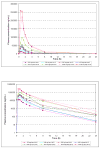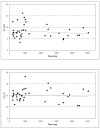Phase I and correlative biology study of cilengitide in patients with recurrent malignant glioma
- PMID: 17470857
- PMCID: PMC3811028
- DOI: 10.1200/JCO.2006.06.6514
Phase I and correlative biology study of cilengitide in patients with recurrent malignant glioma
Abstract
Purpose: This multi-institutional phase I trial was designed to determine the maximum-tolerated dose (MTD) of cilengitide (EMD 121974) and to evaluate the use of perfusion magnetic resonance imaging (MRI) in patients with recurrent malignant glioma.
Patients and methods: Patients received cilengitide twice weekly on a continuous basis. A treatment cycle was defined as 4 weeks. Treatment-related dose-limiting toxicity (DLT) was defined as any grade 3 or 4 nonhematologic toxicity or grade 4 hematologic toxicity of any duration.
Results: A total of 51 patients were enrolled in cohorts of six patients to doses of 120, 240, 360, 480, 600, 1,200, 1,800, and 2,400 mg/m2 administered as a twice weekly intravenous infusion. Three patients progressed early and were inevaluable for toxicity assessment. The DLTs observed were one thrombosis (120 mg/m2), one grade 4 joint and bone pain (480 mg/m2), one thrombocytopenia (600 mg/m2) and one anorexia, hypoglycemia, and hyponatremia (800 mg/m2). The MTD was not reached. Two patients demonstrated complete response, three patients had partial response, and four patients had stable disease. Perfusion MRI revealed a significant relationship between the change in tumor relative cerebral blood flow (rCBF) from baseline and area under the plasma concentration versus time curve after 16 weeks of therapy.
Conclusion: Cilengitide is well tolerated to doses of 2,400 mg/m2, durable complete and partial responses were seen in this phase I study, and clinical response appears related to rCBF changes.
Figures



Comment in
-
Integrin inhibitors reaching the clinic.J Clin Oncol. 2007 May 1;25(13):1637-8. doi: 10.1200/JCO.2006.09.8376. J Clin Oncol. 2007. PMID: 17470853 No abstract available.
Similar articles
-
Phase I trial of irinotecan plus temozolomide in adults with recurrent malignant glioma.Cancer. 2005 Oct 1;104(7):1478-86. doi: 10.1002/cncr.21316. Cancer. 2005. PMID: 16088964 Clinical Trial.
-
Phase I clinical trial of cilengitide in children with refractory brain tumors: Pediatric Brain Tumor Consortium Study PBTC-012.J Clin Oncol. 2008 Feb 20;26(6):919-24. doi: 10.1200/JCO.2007.14.1812. J Clin Oncol. 2008. PMID: 18281665 Clinical Trial.
-
Phase I trial of temozolomide using an extended continuous oral schedule.Cancer Res. 1998 Oct 1;58(19):4363-7. Cancer Res. 1998. PMID: 9766665 Clinical Trial.
-
Cilengitide treatment for malignant glioma: current status and future direction.Neurol Med Chir (Tokyo). 2012;52(8):539-47. doi: 10.2176/nmc.52.539. Neurol Med Chir (Tokyo). 2012. PMID: 22976135 Review.
-
Targeting integrins in malignant glioma.Target Oncol. 2010 Sep;5(3):175-81. doi: 10.1007/s11523-010-0156-3. Epub 2010 Sep 4. Target Oncol. 2010. PMID: 20820929 Review.
Cited by
-
A novel PET tracer for targeted imaging of atherosclerosis.J Nucl Cardiol. 2015 Dec;22(6):1191-4. doi: 10.1007/s12350-015-0088-5. Epub 2015 Feb 28. J Nucl Cardiol. 2015. PMID: 25721316 No abstract available.
-
Molecular interactions of ErbB1 (EGFR) and integrin-β1 in astrocytoma frozen sections predict clinical outcome and correlate with Akt-mediated in vitro radioresistance.Neuro Oncol. 2013 Aug;15(8):1027-40. doi: 10.1093/neuonc/not046. Epub 2013 Apr 17. Neuro Oncol. 2013. PMID: 23595626 Free PMC article.
-
A comparative assessment of the effects of integrin inhibitor cilengitide on primary culture of head and neck squamous cell carcinoma (HNSCC) and HNSCC cell lines.Clin Transl Oncol. 2019 Aug;21(8):1052-1060. doi: 10.1007/s12094-018-02025-3. Epub 2019 Jan 10. Clin Transl Oncol. 2019. PMID: 30632010
-
MGMT promoter methylation is not correlated with integrin expression in malignant gliomas: clarifying recent clinical trial results.Med Oncol. 2018 Jun 7;35(7):103. doi: 10.1007/s12032-018-1162-z. Med Oncol. 2018. PMID: 29882028
-
Clinical biomarkers of angiogenesis inhibition.Cancer Metastasis Rev. 2008 Sep;27(3):415-34. doi: 10.1007/s10555-008-9143-x. Cancer Metastasis Rev. 2008. PMID: 18414993 Free PMC article. Review.
References
-
- Published by the Central Brain Tumor Registry of the United States CBTRUS: Statistical Report: Primary Brain Tumors in the United States 1997-2001. 2004
-
- Stupp R, Mason WP, van den Bent MJ, et al. Radiotherapy plus concomitant and adjuvant temozolomide for glioblastoma. N Engl J Med. 2005;352:987–996. - PubMed
-
- Tatter SB. Recurrent malignant glioma in adults. Curr Treat Options Oncol. 2002;3:509–524. - PubMed
-
- Libermann TA, Nusbaum HR, Razon N, et al. Amplification, enhanced expression and possible rearrangement of EGF receptor gene in primary human brain tumors of glial origin. Nature. 1985;313:144–147. - PubMed
-
- Watanabe K, Tachibana O, Sata K, et al. Overexpression of the EGF receptor and p53 mutations are mutually exclusive in the evolution of primary and secondary glioblastomas. Brain Pathol. 1996;6:217–223. - PubMed
Publication types
MeSH terms
Substances
Grants and funding
LinkOut - more resources
Full Text Sources
Other Literature Sources
Medical

